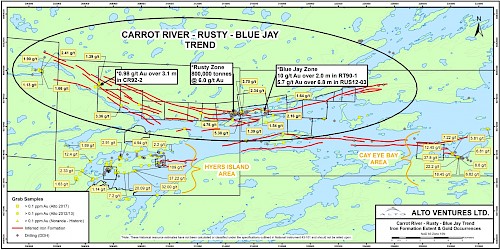Vancouver, B.C., November 6, 2017. Alto Ventures Ltd. (ATV: TSX-V) is pleased to announce highlights of results from the 2017 summer program along the Carrot River-Rusty-Blue Jay trend on the Oxford Lake project in Manitoba (Figure 1). The Carrot River-Rusty-Blue Jay trend is a 30 km trend of aeromagnetic highs associated with banded iron formation ("BIF") units which host the historical 154,000 ounce Rusty Gold Deposit*, the multiple, high grade Blue Jay Gold Zone and the solitary hole drilled by Noranda 10 km further west in the Carrot River area intersecting gold in 10.3 m of BIF. Bedrock exposures on the trend west of the Rusty Gold Deposit are sparse due to overburden cover, however Alto's prospecting team made significant new discoveries. Given the previous gold intersections in drilling and recent prospecting discoveries, there is encouragement for discovery of a major BIF gold deposit on the Oxford Lake project.
New gold occurrences discovered included up to 3.36 g/t Au in grab samples from quartz veinlets within a mostly-buried outcrop of pyrrhotite-bearing bedded chert-siltstone, flanking a strong aeromagnetic linear interpreted to be related to BIF. At another location, an assay of 1.39 g/t Au was obtained from a grab sample of quartz veinlets in sheared gabbro located immediately north of the historical Noranda hole CR92-2 which reported 0.98 g/t Au over 3.1 m hosted by BIF. Other significant gold anomalies were obtained from the Brogden Lake area located at the west end of the Carrot River-Rusty- Blue Jay trend. Grab sampling of a historical gold showing here returned up to 2.41 g/t Au associated with a narrow, banded magnetite-chert iron formation.
Outcrops of the original Rusty BIF gold occurrence were cleaned and sampled, returning grab sample values up to 5.38 g/t Au. New gold mineralization, up to 2.16 g/t Au in banded tuff/metasedimentary rocks, was found just south of Blue Jay Zone and the main BIF trend.
The abundance of gold occurrences along this trend, including the Rusty Gold Deposit and Blue Jay Zone, and those in the Carrot River and Brogden Lake areas confirm the strong gold tenor of the 30 km long Carrot River-Rusty-Blue Jay BIF trend. The Company is preparing for a 3000 metre winter 2018 diamond drilling program.
The Rusty and Blue Jay Banded Iron Formation Mineralization
The historical Rusty Gold Deposit and Blue Jay Zone lie along the 30 km trend of aeromagnetic highs associated with BIF units. The Rusty Gold Deposit was discovered by Noranda in 1990 and is reported to host a Historical Resource* of 800,000 tonnes averaging 6 g/t Au and containing approximately 154,000 ounces of gold associated with BIF. In 2012, Alto drilled hole RUS12-03 in the Blue Jay area approximately two kilometres on trend and east of the Rusty Deposit. RUS12-03 intersected two zones of high-grade gold mineralization associated with the same extensive BIF units as the Rusty Deposit. Results from one zone are 2.7 metres averaging 6.7 g/t gold including 22.5 g/t gold over 0.5 metres and from the second zone - 6.8 metres averaging 5.7 g/t gold including 11.7 g/t gold over 1.6 metres and 16.5 g/t gold over 1 metre.
Of prime significance, a single diamond drill hole completed in 1992 along this 30 km aeromagnetic trend intersected 0.98 g/t over 3.1 m within a 10.3 metre section of BIF in the Carrot River area located approximately 10 km west of the Rusty Gold Deposit. Minimal past exploration was completed in the overburden covered Carrot River area along this trend of tremendous potential for BIF gold mineralization.
* The historical resources were estimated prior to NI43-101 standards being enacted and a Qualified Person (QP), as defined by NI43-101, has not done sufficient work to classify these historical estimates as current mineral resources. Alto is not treating the historical estimate as current mineral resources, as defined by NI43-101, and thus the historical estimates should not be relied upon.
District Scale Exploration Potential of the Oxford Lake Property
The Oxford Lake property covers 36,000 ha of geology prospective for hosting BIF associated gold deposits, syn-orogenic gold deposits and gold associated with sulphide copper-zinc-silver mineralization. In total, 803 rock grab samples were collected from three areas, the Carrot River-Rusty-Blue Jay trend, Hyers Island and Cat Eye Bay, during the 2017 program of rock grab sampling, geological mapping, and prospecting. In addition to the results described above, very significant results were obtained from Alto's work in the Hyers Island and Cat Eye Bay areas.
The Hyers Island area lies near the south end of this large property, approximately six kilometres southwest from the Rusty gold deposit. Verification grab samples from historical occurrences returned up to 109 g/t Au within a 15cm wide quartz-sulphide-carbonate vein from the south shore of Hyers Island; the vein also includes 16.9 g/t Ag, 0.7% Cu and 24% Zn (see Alto Ventures news release dated September 19,2017). Several other notable gold and gold-base metals samples were obtained from narrow quartz-sulphide veins and sulphide pods near the south shore of Hyers Island including 7.2 g/t Au and 83.7 g/t Ag; 2.1 g/t Au and 24.1 g/t Ag; 1.2 g/t Au and 14.5 g/t Ag; and 2.3 g/t Au (see Figure 1).
Significant new gold, silver and zinc assays were obtained from bedrock grab samples mineralized with pyrite and sphalerite on north Hyers Island including 4.9 g/t Au with 51 g/t Ag and 12.7% Zn; 1.8 g/t Au and 15.9 g/t Ag; and 2.9 g/t Au. The mineralized samples are within gossan-stained zones from a few cm to several metres in width, but their extent, controls on mineralization and continuity have not yet been determined. Other new high-grade gold and silver values were obtained from a narrow quartz-sulphide vein located west of Hyers Island. The vein assayed 12.4 g/t Au with 48 g/t Ag.
The Cat Eye Bay area lies near the southeast corner of this large property, approximately 15 km southeast from the Rusty Gold Deposit (see Alto Ventures news release dated October 18, 2017). Grab samples of narrow sulphide mineralized zones from historical trenches returned poly-metallic mineralization including 37.8 g/t Au, 71.9 g/t Ag, 2.5% Cu and 2.5% Zn. Historical drilling in the area of the trenches returned up to 9.3 g/t Au, 89.5 g/t Ag and 4.42% Zn over 0.52 metres core length. As well, two new occurrences were discovered away from the historical trenches. One occurrence, which is located approximately 400 m northwest and possibly along strike from Cat Eye Bay trenches, returned grab sample values up to 12.5 g/t Au and 0.9 g/t Ag. Gold and silver here are hosted by centimeter scale quartz veinlets within magnetite-amphibolite rock interpreted to be highly metamorphosed iron formation. The second occurrence is located approximately 3 km northeast of Cat Eye Bay and gold values up to 5.8 g/t Au, 7 g/t Ag and 1.1% Cu were obtained from quartz-chalcopyrite veinlets hosted by a 20 cm shear zone within mafic volcanics.
The abundance of the high grade showings and their widespread distribution confirm the excellent exploration potential of the Oxford Lake property, both on Alto's main BIF target along the Carrot River-Rusty-Blue Jay trend as well as in the Hyers Island and Cat Eye Bay areas. Additional work is required in the Hyers Island area as well as Cat Eye Bay to better understand the controls on mineralization before drilling is carried out.
Quality Control
Rock grab samples were shipped to the ALS Canada laboratory in Thunder Bay, where the rocks were crushed and pulverized to prepare sample pulps up to 250 grams to 85% passing 75 microns. The pulps were then shipped by ALS Canada to their Vancouver laboratory for gold and multi-element analyses. The gold assaying method uses a standard Fire Assay with AA finish technique on a 30 gram sub-sample taken from a 250 gram split from the submitted sample. Check assays were performed on samples with gold values greater than 10 g/t Au using Fire Assay and Gravimetric finish. Commercially prepared standards were inserted Alto with each batch of samples shipped to ensure precision of the results.
The samples were also tested for 35 other elements using ICP Aqua-Regia digestion (ALS-ME-ICP41 35 element Aqua Regia). Ore grade analyses were performed on certain samples where base metal values exceeded the maximum detection ranges for the ICP-Aqua Regia methods.
Alto's President, Mike Koziol, P. Geo. is a qualified person under the provisions of National Instrument 43-101 and approves the technical data and conclusions in this news release.

Figure 1 Oxford Lake Property Carrot River-Rusty-Blue Jay Trend Iron Formation Extent and Gold Occurrences
About Alto Ventures Ltd
Alto Ventures Ltd. is an exploration and development company with a portfolio of highly prospective Canadian gold properties. The Company is active in the Abitibi greenstone belt in Quebec on the Destiny gold property and is exploring in the Beardmore-Geraldton gold belt in Ontario. In Manitoba, the Company is focused on the gold and base metals potential of the highly prospective but relatively under-explored Oxford Lake property. For more details regarding the Company's projects, please visit our website at www.altoventures.com.
ON BEHALF OF THE BOARD,
Richard J. Mazur, P. Geo.,
CEO
Neither the TSX Venture Exchange nor its Regulation Services Provider (as that term is defined in the policies of the TSX Venture Exchange) accepts responsibility for the adequacy or accuracy of this release.
For further information contact:
Mike Koziol,
President and Director
ALTO VENTURES LTD.
Unit 7 -- 1351C Kelly Lake Rd
Sudbury, ON., P3E 5P5
Tel: 705-522-6372
Email: koziol@altoventures.com
Rick Mazur,
CEO and Director
ALTO VENTURES LTD.
Suite 615-800 W. Pender Street
Vancouver, BC, V6C 2V6
Tel: 604-689-2599
Email: mazur@altoventures.com

